Balbharti Maharashtra State Board Class 9 Geography Solutions Chapter 2 Endogenetic Movements Notes, Textbook Exercise Important Questions and Answers.
Endogenetic Movements Class 9 Questions And Answers Maharashtra Board
Class 9 Geography Chapter 2 Endogenetic Movements Questions And Answers Maharashtra Board
Geography Class 9 Chapter 2 Question Answer Maharashtra Board
1. Tick in front of the correct option ✓
(a) On which of the following are slow movements in the earth’s interior dependent?
Landforms [ ]
Velocity [ ]
Direction [ ]
Answer:
Velocity
![]()
(b) When waves divert from each other, what do they create
Compression [ ]
Tension [ ]
Mountain [ ]
Answer:
Tension
(c) For the formation of a rift valley, which of the following processes should occur in the earth’s crust?
Compression [ ]
Tension [ ]
Weathering [ ]
Answer:
Tension
(d) Which of these is a fold mountain?
The Satpudas [ ]
The Himalayas [ ]
The Western Ghats [ ]
Answer:
The Himalayas
(e) The formation of extensive plateaus is a result of which type of movements?
Mountain-building [ ]
Continent-building [ ]
Horizontal [ ]
Answer:
Continent-building
2. Give geographical reasons.
(a) Buildings collapsed at the foothills of the Himalayas because of an earthquake. Before collapsing they were moving forward and backward.
Answer:
- The seismic waves can be divided into primary, secondary and surface waves.
- The primary waves are the first ones to reach the surface of the earth after the energy is emitted in the Earth’s interior.
- Subjected to a ‘P’ wave, particles in the rock move in the direction of waves to and fro and therefore, these waves are also called forward-backward waves.

- Thus, during an earthquake, the buildings at the foothills of the Himalayas moved forward and backward as they were first subjected to “P” waves.
(b) There is a difference in the formation of the Meghalaya Plateau and the Deccan Plateau.
Answer:
- The Meghalaya plateau is formed due to slow movements (orogenic movements) whereas the Deccan Plateau is formed due to sudden movements (fissure volcano).
- During the formation of the Meghalaya plateau, a part of the Earth’s crust in between two parallel faults was lifted forming a plateau whereas, the Deccan plateau was formed due to molten material coming out with the eruption spreading on both sides of the fissure.
- Thus, there is a difference in the formation of the Meghalaya plateau and the Deccan plateau.
(c) Most of the volcanoes are found on the plate boundaries.
Answer:
- The plate boundaries are directly related to the areas of volcanoes.
- Most of the volcanoes are located on the plate boundaries.
- The part of the plate boundary which slides under the crust, results in the loss of material. Such boundaries are called plate consuming boundaries.
- In areas where new material (magma) is coming up onto the Earth’s crust, they are called plate creating boundaries.
- Both the processes result in earthquakes and volcanoes. Thus, most of the volcanoes are formed in the plate boundaries.
(d) The Barren Island is becoming conical in shape.
Answer:
- Barren island which was considered a dormant volcano has become active since February 2017.
- Mainly dust, smoke and mud are coming out of this eruption along with some lava.
- During eruption, the lava is spread around the mouth of this vent, when it comes out.
- As a result, a cone-shaped mountain starts forming.

Therefore Barren Island is becoming conical in shape.
(e) Volcanic eruptions can cause earthquakes.
Answer:
- Generally, the movements in the Earth’s interior occur in the upper layer of the mantle
- Tremendous energy is released by radioactive materials present here.
- This leads to a sudden movement in form of volcanic eruptions where hot solid, liquid and gaseous materials are forcefully thrown out from the mantle of the Earth, onto the surface of the Earth.
- This causes a lot of instability within the crust of the Earth which would also lead to the release of pressure in the form of seismic waves or tremors causing earthquakes.
3. Identify and name the internal movement.
(a) Tsunamis are generated in coastal areas.
Answer:
Sudden Movement
(b) The Himalayas are an example of fold mountains.
Answer:
Slow movement – Mountain Building Movements.
(c) Molten magma is thrown out of the earth’s mantle.
Answer:
Sudden Movement
(d) Rift valley is formed because of faulting.
Answer:
The slow movement – Upward – Downward Movement.
4. Arrange the following statements in chronological order in which an earthquake occurs.
(a) The earth’s surface vibrates
Answer:
The plates suddenly move.
(b) The plates suddenly move.
Answer:
Due to the movements in the mantle compression goes on increasing.
(c) Due to the movements in the mantle, compression goes on increasing.
Answer:
Along the weak point (faultlines) rocks break apart.
(d) Along the weak points ( faultlines) rocks break apart.
Answer:
Stored energy is released in the form of seismic waves.
![]()
(e) Stored energy is released in the form of seismic waves.
Answer:
The earth’s surface vibrates.
5. Distinguish between
(a) Block Mountain and Fold Mountain
Answer:
| Block Mountain | Fold Mountain |
| (i) When a part of the earth’s crust between two parallel faults is lifted a block mountain is formed. | (i) Because of the energy waves and pressure working towards each other, the layers of the soft rocks form folds leading to the formation of fold mountains. |
| (ii) Block mountains are formed due to tension. | (ii) Fold mountains are formed due to compression. |
| (iii) e.g. The Black forest mountains of Europe and the Meghalaya Plateau of India. | (iii) e.g. The Himalayas, the Aravalis, the Rockies, the Andes, the Alps |
(b) Primary and Secondary Seismic Waves
Answer:
| Primary Seismic Waves | Secondary Seismic waves |
| (i) Primary waves are the first one to reach the surface of the earth after the energy is emitted in the Earth’s interior. | (i) The waves which reach the Earth’s surface after the primary waves are called secondary waves. |
| (ii) Primary waves can travel through solid, liquid and gaseous medium. | (ii) Secondary waves can travel only through only solid medium. |
| (iii) While travelling through liquid medium, primary waves change their direction. | (iii) Secondary waves get absorbed as they enter the liquid medium. |
| (iv) The waves move to and fro in the direction of energy transfer. | (iv) These waves move up and down in the direction of energy transfer. |
(c) Earthquakes and volcanoes
Answer:
| Earthquakes | Volcanoes |
| (i) Earthquake is the movement of the Earth’s crust. | A volcano is an opening in the Earth’s crust from which hot solid, liquid and gaseous materials are thrown out from the mantle of. |
| (ii) Nothing is ejected out during an earthquake. | During a volcanic eruption, ash, water vapor, various types of poisonous and inflammable gases, hot molten magma etc. is ejected from the earth’s interior. |
6. Answer in brief
(a) Give reasons why an earthquake occurs.
Answer:
- When the movements occur in the interior of the Earth, tremendous tension is created in the Earth’s crust.
- When the tension goes beyond limits, the energy is released in the form of waves.
- This results in the trembling of the earth’s surface, i.e. an earthquake occurs.
![]()
Following are the reasons for the occurrence of an earthquake:
- Moving of the plates
- Colliding of the plates
- Plates sliding one below the other
- Forming of fractures in rock layers, due to tension in the interior of the Earth.
- Occurring of volcanic eruption
(b) Which type of movements have led to the formation of the major fold mountains in the world?
Answer:
- Fold mountains are formed due to mountain-building (erogenic) movements.
- Energy is transferred from the interior of the Earth. Because of these energy waves and pressure working towards each other and in horizontal direction, the layers of the soft rocks form folds.
- If the pressure is very high, large scale folds are formed and their complexity increases.
- As a result, the surface of the Earth gets uplifted and fold mountains are formed.
- The Himalayas, the Aravalis, the Rockies, the Andes, the Alps are the major fold mountains of the world.
(c) How is the magnitude of the earthquake-related to the collapse of houses
Answer:
- Through a seismogram, a graph showing movement of seismic waves (seismograph) can be generated.
- After studying this graph, the magnitude of the earthquake is known.
- The magnitude of the earthquake is measured with the help of a richter scale.
- It is because of the primary waves that the buildings on the Earth’s surface move back and forth.
- The buildings on the Earth’s surface move up and down because of the secondary waves. These are more destructive than the T’ waves leading to collapse of buildings.
(d) What are the effects of earthquakes on the earth’s surface and human life?
Answer:
Following are the effects of earthquakes:
- Cracks/fractures develop on the ground.
- These causes landslides which leads to sliding of rocks.
- Sometimes the groundwater changes its course. For example, wells may get water, or may dry up.
- Some areas get uplifted while some may subside.
- Tsunamis are generated in oceans These waves can cause great loss of life and property in the coastal areas.
- In snow-covered areas, avalanches may occur.
- Buildings collapse and loss of life and property occurs.
- Transportation routes get disrupted.
- The communication system collapses.
(e) Explain the types of seismic waves.
Answer:
When the intension is released at the focus, the released energy travels in all directions. This energy comes towards the Earth’s surface in the form of waves. The seismic waves can be divided into primary, secondary and surface waves.
(i) Primary or ‘P’ waves:
- These waves are first to reach the surface of the Earth, after the energy is emitted in the Earth’s interior. They travel at a very fast speed from the focus of the earthquake in radial direction.
- The waves moves to and fro, therefore these waves are called forward-backward waves.
- These waves can travel through all the three states – liquid, solid and gaseous.
- While travelling through liquid medium, their direction gets changed. It is because of the primary waves that the buildings on the Earth’s surface move back and forth.
![]()
(ii) Secondary or ‘S’ waves :
- The waves which reach the Earth’s surface after I the primary waves are called secondary waves. :
- These waves also scatter in all directions from the focus of the earthquake.
- Their velocity is less than ’P’ waves.
- The particles lying in the way of these waves j move up and down in the direction of energy transfer.
- These waves can travel only through the solid medium and they get absorbed as they enter the liquid medium.
- The buildings on the Earth’s surface move up and down because of these waves. These are more destructive than ‘P waves.
(iii) Surface or ‘L’ waves :
- These waves are generated after the main ’P’ and ‘S’ waves reach the epicenter.
- They travel in the direction of the circumference of the Earth, along the crust and are highly destructive.
(f) Explain the types of volcanoes on the basis of the periodicity of eruption with examples.
Answer:
According to the periodicity of the volcanic eruptions, three types of volcanoes can be identified.
(i) Active Volcanoes –
- If the volcanic eruptions are regular even in the present times, then such volcanoes are called active volcanoes.
- E.g., Mt Fujiyama in Japan and Mt. Stromboli in the Mediterranean Sea.
(ii) Dormant Volcanoes –
- When a volcano has not erupted since long, but may become active suddenly is called a dormant volcano.
- E.g., Mt. Vesuvius in Italy, Mt. Katmai in Alaska and Barren Island, India.
(iii) Extinct volcanoes –
- Those volcanoes which have not erupted in the past since long and are not likely to erupt in the future are called extinct volcanoes.
- E.g., Mr. Kilimanjaro in Tanzania.
7. Show the epicenter, focus and the primary, secondary and surface waves of an earthquake with the help of a neat labeled diagram.
Answer:
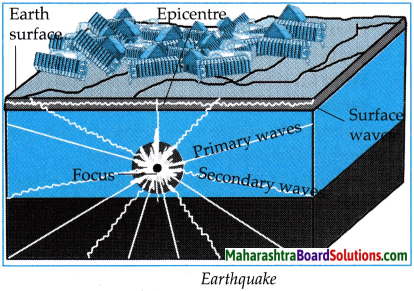
8. Show the following on a given outline map of the world.
(a) Mt. Kilimanjaro
(b) Mid-Atlantic Earthquake zone
(c) Mt. Fuji
(d) Krakatoa
(e) Mt. Vesuvius
Answer:
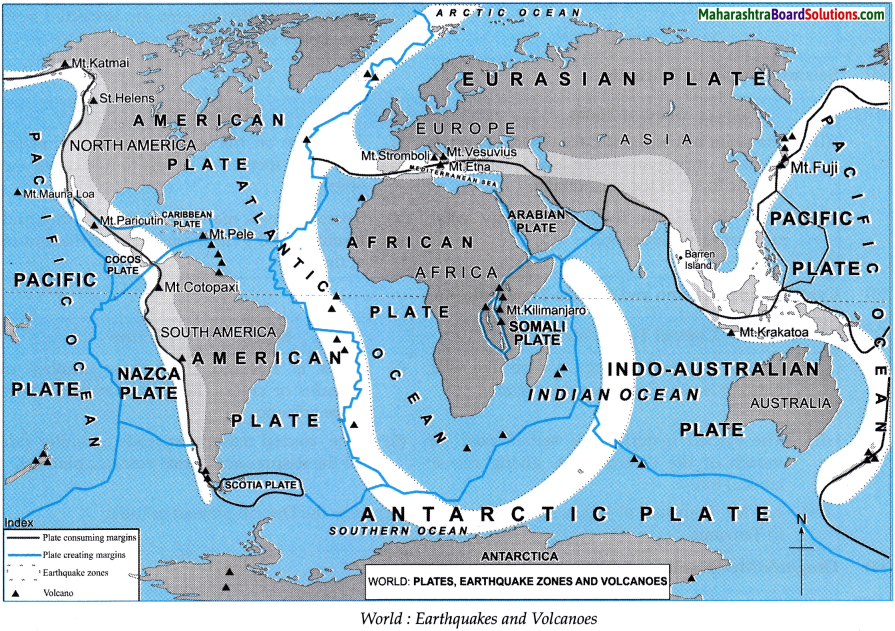
Class 9 Geography Chapter 2 Endogenetic Movements Intext Questions and Answers
Can you tell?
Read the following news. Observe the photograph and answer the questions.

Question 1.
What caused large-scale casualties?
Answer:
Calamity of earthquake led to large scale casualties.
![]()
Question 2.
What was the magnitude of the earthquake?
Answer:
The magnitude of the earthquake was 7.9 Richter scale.
Question 3.
Which country was the most affected because of this earthquake?
Answer:
Nepal was most affected because of this earthquake.
Question 4.
Where was the epicentre of the earthquake?
Answer:
Lamjung in Nepal was the epicentre of the earthquake.
Question 5.
Which are the other affected areas?
Answer:
Bihar, West Bengal and Uttar Pradesh in India as well as China, Bhutan, Pakistan and Bangladesh were affected by earthquake.
Question 6.
At what depth was the focus located?
Answer:
The focus of the earthquake was located at the depth of 11 km.
Question 7.
What kind of damage is seen because of the earthquake?
Answer:
Nearly 1500 people were killed and over 1000 people were injured in the disaster.
Question 8.
According to you, what could be the reason behind the earthquake?
Answer:
The sudden release of energy from the interior of the earth leads to earthquakes.
Question 9.
Have you ever experienced a similar earthquake? Discuss.
Answer:
Answers may vary.
Class 9 Geography Chapter 2 Endogenetic Movements Additional Important Questions and Answers
Complete the statements choosing the correct option from the bracket:
Question 1.
Richter scale is a unit of measuring the magnitude of a/an
(a) volcano
(b) creation of plate
(c) earthquake
(d) earth movement
Answer:
(c) earthquake
![]()
Question 2.
There are in all major plates on the Earth.
(a) five
(b) seven
(c) nine
(d) four
Answer:
(b) seven
Question 3.
Large scale and sudden release of energy in the interior of the Earth gives rise to Earth movements.
(a) slow
(b) sudden
(c) internal
(d) external
Answer:
(b) sudden
Question 4.
Earthquakes occur due to the movement of
(a) plates
(b) earth
(c) oceans
(d) land
Answer:
(a) plates
Question 5.
Earthquake is measured with the help of an instrument called a
(a) seismogram
(b) thermometer
(c) barometer
(d) hygrometer
Answer:
(a) seismogram
Question 6.
If lava is released through a vent, it is called a vent volcano.
(a) fissure
(b) central
(c) upper
(d) below
Answer:
(b) central
Question 7.
Kilimanjaro is a volcano.
(a) central type
(b) fissure type
(c) extinct type
(d) dormant type
Answer:
(a) central type
![]()
Question 8.
A tremendous amount of energy is given out by the radioactive elements in the
(a) crust
(b) core
(c) mantle
(d) sial
Answer:
(c) mantle
Question 9.
The movements that give rise to mountains are called movements.
(a) epiorogenic
(b) orogenic
(c) slow
(d) sudden
Answer:
(b) orogenic
Question 10.
When a portion of the crust between two parallel faults2 is raised up, it is called a mountain.
(a) block
(b) fold
(c) residual
(d) ancient
Answer:
(a) block
Question 11.
The area between two adjoining faults subsides, such area of subsidence is called
(a) rift valley
(b) block mountain
(c) fold mountain
(d) faulting
Answer:
(a) rift valley
Question 12.
Black Forest Mountain in Europe is a mountain.
(a) fold
(b) residual
(c) block
(d) ancient
Answer:
(c) block
Question 13.
The movements that give rise to continents are
(a) orogenic
(c) fold
(b) epeirogenic
(d) fault
Answer:
(b) epeirogenic
![]()
(Endogenetic Movements Class 9 Geography Chapter 2 )Tick in front of the correct option.
Question 1.
Which of these is a block mountain?
(a) Black forest mountain
(b) Alps
(c) Andes
Answer:
(a) Black forest mountain
Question 2.
Which type of volcano has eruptions regularly even during present times?
(a) Dormant
(b) Extinct
(c) Active
Answer:
(c) Active
Give one word for each of the following:
Question 1.
A volcano, where lava reaches the surface through a vent or a pipe.
Answer:
Central Vent Volcano
Question 2.
An instrument, which is used for recording earthquakes.
Answer:
Seismogram
Question 3.
The surface position immediately above the origin of an earthquake.
Answer:
Epicenter
Question 4.
An example of a volcanic plateau.
Answer:
Deccan Plateau.
Question 5.
An example of Conical volcanic mountains.
Answer:
Mt. Kilimanjaro
![]()
(Class 9 Geography Chapter 2 Endogenetic Movements Questions And Answers ) Answer in one sentence each.
Question 1.
What are Endogenetic processes?
Answer:
Endogenetic processes are processes that originate internally in the Earth’s surface. E.g. earthquakes, volcanoes, continent building, mountain building etc.
Question 2.
What is a Richter scale?
Answer:
It is a scale for expressing the magnitude of an earthquake.
Question 3.
What is a Focus or Hypocentre?
Answer:
The point below the Earth’s surface where energy is released during an earthquake is called the focus of the earthquake.
Question 4.
What are Primary Waves?
Answer:
The earthquake waves that reach the surface of the Earth first, immediately after the energy is released in the interior of the Earth, are called Primary waves.
Question 5.
What are Secondary Waves?
Answer:
The earthquake waves reporting at the surface after the primary waves are called the secondary waves.
Question 6.
What are Surface Waves?
Answer:
Primary and secondary waves affect the surface on reaching it. As a result a new set of waves gets generated at the surface. These waves are called surface waves.
Question 7.
What are Plates?
Answer:
The parts of varying sizes of the Earth’s crust floating on the upper portion of the mantle are called plates.
Question 8.
What do you mean by an Epicentre?
Answer:
The point located on the surface of the Earth nearest to the focus is called the epicenter of the earthquake.
Question 9.
Explain Orogenic Movements
Answer:
The slow movements in the interior of the Earth that give rise to mountains are called orogenic movements (mountain building movements).
![]()
Question 10.
What is Folding1?
Answer:
As energy moves through the interior of the Earth, soft rocks are subjected to pressure leading to creation of folds called folding.
Question 11.
Define Fault.
Answer:
The fracture line created in a rock due to the energy waves moving away from each other is called a fault.
Question 12.
What is a Block Mountain?
Answer:
A raised portion of the crust between two parallel faults is called a block mountain.
Question 13.
What is a Rift valley?
Answer:
The area of subsidence between two adjoining faults is called a rift valley.
Question 14.
Explain Epeirogenic Movements.
Answer:
The Earth’s slow movements that give rise to continents and extensive plateaus are called epeirogenic movements.
Question 15.
Explain the process of Volcanic Eruption.
Answer:
A process in which hot solid, liquid and gaseous materials are thrown out from the mantle of the earth onto the surface of the earth, is called volcanic eruption.
Identify and name the internal movements.
Question 1.
Dust, smoke and mud with some lava coming out of Barren Island.
Answer:
Sudden Movement
![]()
Distinguish between:
Question 1.
Seismic Focus and Epicentre
Answer:
| Seismic Focus | Epicenter |
| (i) The point below the surface where energy is released during an earthquake is called the seismic focus of the earthquake. | (i) The place on the surface which is directly above the focus and closest to it is called the epicenter. |
| (ii) From the seismic focus, an energy wave radiates in all directions. | (ii) Seismic waves reach the epicenter first and foremost and so its intensity is the maximum at this point. |
Question 2.
Central Type Volcano and Fissure Type Volcano
Answer:
| Central Type Volcano | Fissure Type Volcano | ||
| (i) | Lava is released through a pipe-like vent, hence it is called central type volcano. | (i) | Lava is released through a number of fissures or cracks, hence it is called fissure type volcano. |
| (ii) | The ejected material gets settled near the mouth of the central vent, giving rise to conical hills. | (ii) | The ejected material spreads on either side of the fissures and forms volcanic plateaus. |
| (iii) | e.g. Mt. Fujiyama of Japan, Mt. Kilimanjaro in Tanzania. | (iii) | e.g. the Deccan plateau of India |
Question 3.
Orogenic Movements and Epeirogenic Movements
Answer:
| Orogenic Movements | Epeirogemic Movements |
| (i) The movements that give rise to mountains are called Orogenic Movements. | (i) The movements that give rise to continents are called Epeirogenic Movements. |
| (ii) They lead to the formation of Fold mountains, Block mountains and Rift valleys. | (ii) They lead to the formation of continents and extensive plateaus. |
Question 4.
Slow Internal Movements and Sudden Internal Movements
Answer:
| Slow Internal Movements | Sudden Internal Movements |
| (i) The movements in the interior of the earth that are caused by continuous and slow release of energy are called slow internal movements | (i) The movements in the interior of the earth that are caused by the sudden release of energy on a large scale are called sudden internal movements. |
| (ii) Slow internal movements give rise to mountains and continents. | (ii) Sudden internal movements lead to earthquakes and volcanic eruptions. |
Make friends with Maps!
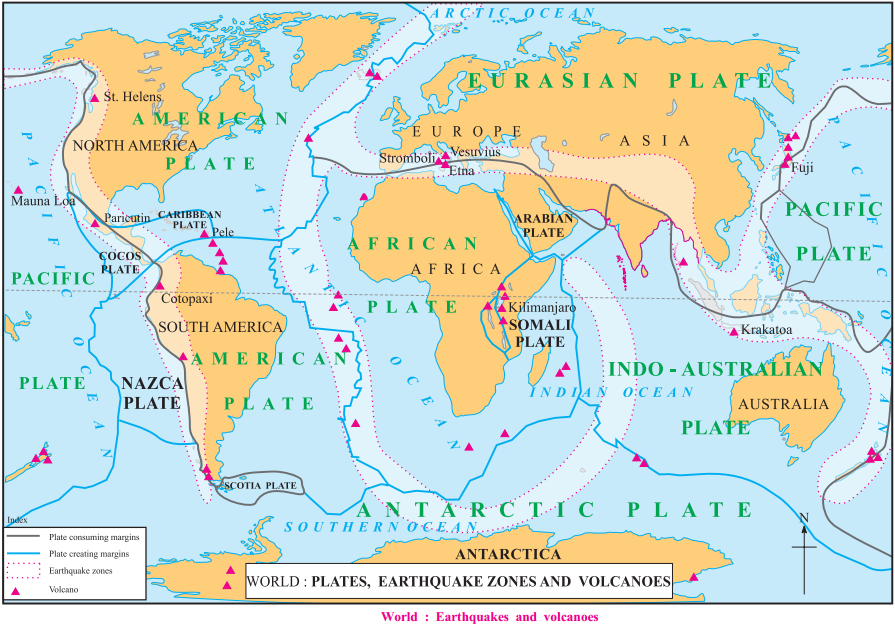
Answer the following questions:
Question 1.
Examine the plate boundaries in the given map and write the names of the plates.
Answer:
North American Plate, South American Plate, Indo-Australian Plate, African Plate, Eurasian Plate, Pacific Plate, Antarctic Plate, Arabian Plate, Nazca Plate, Cocos Plate, Caribbean Plate, Scotia Plate, Arabian Plate and Somali Plate.
![]()
Question 2.
On which side of the continents of North and South America are the earthquake-prone zones located? Which mountains are located there?
Answer:
The earthquake-prone zone is located on the western side of North and South America. Rockies and Andes mountain ranges are located there.
Question 3.
In which mountainous zone in Asia does the earthquake-prone zone lie?
Answer:
The Himalayan mountainous zone of Asia is an earthquake-prone zone.
Question 4.
In which region are the volcanoes concentrated in Africa? What could be the reason?
Answer:
Volcanoes are concentrated in the eastern part of Africa along the Rift Valley region as this region is located on plate boundaries.
Question 5.
Correlate earthquake regions, distribution of volcanoes and plate boundaries.
Answer:
Plate boundaries are directly related to areas of earthquakes and volcanoes. Most of the volcanoes are located on the plate boundaries. Similarly, the earthquake zones are also seen in the border areas.
Give geographical reasons:
Question 1.
The secondary earthquake waves are very destructive.
Answer:
- Due to secondary earthquake waves, the grains in the rocks move up and down, that is, perpendicular to the direction of the movement of the waves.
- Therefore, secondary waves are very destructive.
Answer in brief:
Question 1.
Explain the types of volcanoes on the basis of their type of eruption, with examples.
Answer:
On the basis of the type of eruption, volcanoes can be divided into two types.
(i) Central-type or conical volcano:
- During eruption, the molten magma comes out through a pipe-like vent from inside the Earth’s surface. The lava spreads around the mouth of this vent, when it comes out.
- Asa result, cone-shaped mountains start forming and conical volcanic mountains are formed.
- Mt. Fujiyama in Japan and Mt. Kilimanjaro in Tanzania are examples of central-type volcanoes and conical mountains.
![]()
(ii) Fissure-type volcano:
- During eruption, when the magma comes out not from a single vent, but from many cracks (fissures), it is called fissure-type volcanic eruption.
- The molten material coming out with the eruption spreads on both the sides of the fissure. ;
- As a result, volcanic plateaus are formed.
- The Deccan Plateau of India has also been formed due to such a type of volcanic eruption.
Question 2.
Describe the changes that take place on the surface of the Earth, due to the movements taking place in the interior of the Earth.
Answer:
The changes taking place on the surface of the Earth, due to the internal movements of the Earth are as follows:
- The soft rocks are subjected to pressure due to the energy released in the interior of the Earth. This leads to the development of folds.
- If the pressure is very high, large scale folds are formed, and their complexity increases. As a result, the surface of the Earth gets uplifted and fold mountains are formed.
- When the energy waves move away from each other, tension in the rock is developed. In hard rocks, the tension leads to faulting, when a portion between two parallel faults is raised up, block mountains are created.
- Sometimes, when the portion between two parallel faults subsides, a rift valley is created.
- Sometimes, an extensive portion is raised to form a continent or an extensive plateau.
Question 3.
How are continents and extensive plateaus formed?
Answer:
- The epeirogenic movements are responsible for the formation of continents.
- Slow movements occur towards the centre or from the Earth’s centre towards the Earth’s crust.
- Because of these movements, a vast part of the Earth’s crust is uplifted or gets subsided.
- When the part of the Earth’s crust is uplifted above the sea mean level, continents are formed.
- Therefore, these movements are called continent-building movements.
- Extensive plateaus can also be formed because of such movements.
Question 4.
What are the effects of volcanoes?
Answer:
The following are the effects of volcanoes:
- Loss of life and property.
- Sometimes tsunamis get generated due to volcanic eruptions occurring below ocean floors.
- Dust, smoke, ash, gases, water vapour, etc. remain in the atmosphere for a long time.
- This may create an imbalance in the environment.
- Land may become fertile due to volcanic ash.
- Many minerals are found near the earth’s surface because of lava.
- New land is formed due to volcanic eruption or at times, an island may even disappear.
- Lakes are formed at the mouth of the craters of dead volcanoes when rainwater accumulates in them.
![]()
Question 5.
Explain the process of the formation of Block mountains.
Answer:
- Because of internal movements, horizontal waves moving away from each other are formed.
- This causes tension on the layers of rocks leading to the formation of fractures in the rocks called as faults.
- Similarly, waves coming towards each other in hard rocks also form faults due to compression.
- When a part of the earth’s crust in between two parallel faults is lifted, it looks like a block. Such a landform is called as a Block mountain.
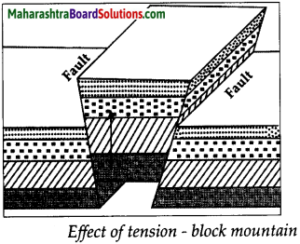
Question 6.
Explain the process of formation of Rift valley.
Answer:
- When horizontal movements on the earth’s surface act in opposite direction, it causes tension on the rocks in the earth’s crust.
- When tension increases, fractures develop in the rocks leading to the formation of faults.
- Consequently, rocks on both the ends slide and the continuity in the layers of rocks is not found.
- Sometimes, two fractures develop side-by-side in the earth’s crust and land in between the two fractures subsides. This subsided deep part is called the rift valley.
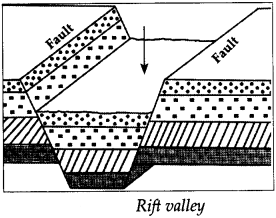
![]()
9th Std Geography Questions And Answers:
- Distributional Maps Class 9 Geography Questions And Answers
- Endogenetic Movements Class 9 Geography Questions And Answers
- Exogenetic Movements Part 1 Class 9 Geography Questions And Answers
- Exogenetic Movements Part 2 Class 9 Geography Questions And Answers
- Precipitation Class 9 Geography Questions And Answers
- Properties of Sea Water Class 9 Geography Questions And Answers
- International Date Line Class 9 Geography Questions And Answers
- Introduction to Economics Class 9 Geography Questions And Answers
- Trade Class 9 Geography Questions And Answers
- Urbanisation Human Class 9 Geography Questions And Answers
- Transport and Communication Class 9 Geography Questions And Answers
- Tourism Class 9 Geography Questions And Answers